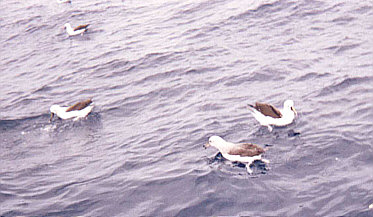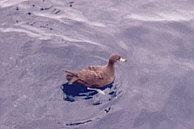|
|
PERTH PELAGIC - 5th September 1999
By Ricky Fairhead
Photos Robert Wilton

Ricky Fairhead (facing camera) with real seabirds in the background,
many assumed this must have been a clever fake.
During the summer of 1999 I was fortunate to spend three weeks in Perth, Western Australia, when I joined up with one of our less successful exports, namely, Robert Wilton. The highlight of my visit was the chance to experience a proper pelagic, with hopefully some decent seabirds thrown in. The previous couple of days had seen storms off the coast of Perth so our expectations were high of a good day. But hang on, I was going to be on board, and my previous success with seabirds had shall we say been less than spectacular, although my luck may be about to change.

Our foreign correspondent, Robert Wilton, temporarily resident in Australia.
So the morning of September 5th found myself and Robert at Hillarys Boat Harbour at 7:00 am. The weather was cold at only 4 degrees celsius so we were decked out in our full winter plumage, with Robert sporting his Ipswich Town FC woolly hat and gloves. Here we met the other twenty participants, including a few other Brits, and various other nationalities. Organiser Frank O'Connor introduced which members of the ensemble were best to approach if anybody had any problems with ID, although strangely he didn't mention me! A few birds were present around the harbour, including a few Little Pied (Phalacrocorax melanoleucos), Little Black (P. sulcirostris) and Pied Cormorants (P. varius), a Willie Wagtail (Rhipidura leucophrys) , two Welcome Swallows (Hirundo neoxena) and numerous Silver Gulls (Larus novaehollandiae). Although it was the seabirds we were really after.

Yellow-nosed Albatross
At 7:10am we left the safety of the harbour and moved out into the open sea, neither myself nor Rob had been out to sea before so we were unsure if we would be seasick or not, so we had taken a couple of tablets beforehand, of the stomach settling kind, not the hallucinogenic type. The flat calm sea was rather unexpected, although worrying because for the first twenty kilometres we didn't see anything. My tablets were now taking effect, and I was starting to feel rather dopey (no comments needed here John). Then suddenly four Humpback Whales (Megaptera novaeangliae) were seen distantly off Rottnest Island, with one individual giving particularly good views, and seen jumping fully out of the sea. A group of four birds were then spotted flying low over the water, my heart started to race, seabirds?; no just some Galahs (Cacatua roseicapilla) flying out to Rottnest Island damn it, but still an unusual sight.

Sub-adult Black-browed Albatross (front bird) and Yellow-nosed Albatrosses.
A group of six Bottle-nosed Dolphins (Tursiops truncatus aduncus) then appeared as we ventured out into deeper water, and slowly seabirds started to appear on the horizon. A few Australian Gannets (Morus serrator) were noted, the only Gannet species in these waters, as Cape Gannet (M. capensis) is a real vagrant here. Someone then shouted albatross, and suddenly a medium-sized albatross was alongside the boat. The gleaming white underwing, black bill with yellow culmen (upper edge), and average to small size all pointed to an adult Yellow-nosed Albatross (Diomedea chlororhynchos), the commonest species in these waters, and of the white headed race bassi. A few Brown Skuas (Catharacta antarctica) were then seen, similar to out Great Skua (C. skua), although with more white on the secondaries. Frank then spotted some very distant Wedge-tailed Shearwaters (Puffinus pacificus) off the end of Rottnest Island, although myself and Robert struggled to see them. Fortunately we managed to obtain excellent views of this species whilst seawatching off Rottnest Island itself a few days later.

Mixed seabirds, including Cape Petrel, Yellow-nosed Albatross and Flesh-footed
Shearwaters.
The skipper, Trevor, and deck hand, Dave, then started the chumming using a mixture of lamb fat, pilchards, chicken pellets, pollard and fish oil, which instantly started to pull in the petrels and shearwaters. Suddenly Flesh-footed Shearwaters (P. carneipes) were everywhere around the boat, with the odd bold individual even being hand fed. These birds were very similar to Sooty Shearwater (P. griseus) in appearance, but lack the paler underwing of that species, and have pinker bills and legs. A few Shy Albatross (D. cauta) were occasionally noted, their large size, and gleaming white underwings were distinctive, although strangely they were all immature birds. One individual, on trying to retrieve a piece of stray fish head even landed on the canvas awning above the boat, hardly living up to its name in the process. The smell of the chum was too much for one unfortunate individual who proceeded to top up the chum bucket at regular intervals throughout the rest of the trip.

Flesh-footed Shearwater.
The skipper then turned off the engines and we drifted for sometime, being directly over the edge of the continental shelf in a depth of over 530 metres. A few White-faced Storm Petrels (Pelagodroma marinua) then put in an appearance, along with a number of Great-winged Petrels (Pterodroma macroptera). The wind was now slightly stronger, but was still only 8-12 knots, and the sea remained relatively clam. With a maximum temperature of 18 degrees celsius and with bright sunshine, this was the most comfortable seawatch you could ever experience, and the most prolific. Seabirds were now all round the boat with a few Black-browed Albatross (D. melanophris) now in residence. A small number of Cape Petrels (Daption capense) were also seen, superb pied seabirds, and again very close to the boat. A good number of Soft-plumaged Petrels (P. mollis) were also seen, but none came in as close as the other petrel species. An Arctic Tern (Sterna paradisaea) was the rarest bird seen on this trip, and one which the Aussies got very excited about as it repeatedly circled the fishing boat. The rarest mammals were yet to come as we started to head back to Perth. An unidentified small whale was at one stage seen directly below the boat, which proved to be a Minke Whale (Balaenoptera acutorostrata). We made a special effort to visit Little Island, just off the coast of Perth, where we saw three Australian Sea Lions (Neophoca cinerea), the rarest seal lion species in the world, The Encyclopeadia of Mammals, edited by Dr David Macdonald, published in 1994, quotes a population of just 2000-3000 individuals..

Cape Petrel alighting on water at lower left of picture.
This trip was apparently the best Frank O'Connor had ever had off Perth for the numbers and range of species seen. Myself and Robert thoroughly enjoyed it, and managed to obtain excellent views of the majority of the species. All this for only just over £25 each, not bad considering we went out 61.5 kilometres, and the trip lasted for over eight hours.
The following are the official accounts of bird species seen as defined on Frank O'Connors web page http://www.iinet.net.au/~foconnor/pelagics.htm which gives detailed accounts of each individual pelagic and how to join them.
This particular trip can be found at http://www.iinet.net.au/~foconnor/p990905.htm
Cape Petrel
16
Great-winged Petrel
15
Soft-plumaged Petrel
15
Wedge-tailed Shearwater 10
Flesh-footed Shearwater 200+
Black-browed Albatross 15
Shy Albatross
9
Yellow-nosed Albatross 185
White-faced Storm Petrel 7
Australian Gannet
50
Brown Skua
6
Silver Gull
40
Crested Tern (S. bergii)
25
Roseate Tern (S. dougallii) 2
Arctic Tern
1
Fairy Tern (S. nereis)
3
For details of other pelagics avaible around Australia check out the
Australian Pelagic Birding Webpage at http://www.zipworld.com.au/~palliser/
This page also has an excellent photograph section.